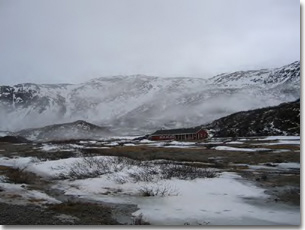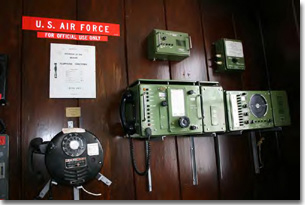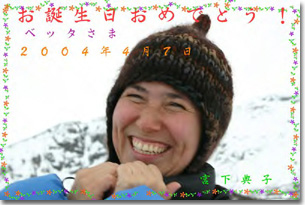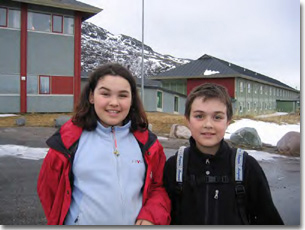|
Narsarsuaq Memorandum
It's not just on the ice cap that the day's activities are affected by the weather.
Here in Narsarsuaq it's been raining for 4 consecutive days.
When I asked about the flight schedule at an office in the airport,
I was told that the direct flights from Copenhagen to Narsarsuaq for last 2 days had been cancelled,
and the alternative route (Copenhagen - Kangerlussaq - Nuuk - Narsarsuaq) was scheduled.

Rain in Narsarsuaq continued for 4 days
Narsarsuaq's history started in 1941 when it was built as a US military base.
In 1945, Narsarsuaq, functioning as a central connecting base of transatlantic bombers,
was the largest city in Greenland with population of 12,000 (most of them were US military personnel).

Remains of war machinery, a remnant of World War II,
found in an out-of-the-way corner of the town

Communication equipment used by the US air force during the war
Narsarsuaq, Greenland's southern gateway,
has long runways serving many jumbo jets arriving from overseas.
At present, about 120 people, mostly workers and their families in air and tourism industry,
live in the town.
In the town museum, there displayed an assortment of weaponry, communication equipment,
slot machines, and monochrome photographs.
The images of cheerful people on display created an atmosphere that contrasted starkly with the present day Narsarsuaq where only the airport and grand nature remain after the war.

Marlene Dietrich, a star actress of those days,
made a visit to Narsarsuaq at the time of World War II
Greenland, a land that is large but small
There is a road in Narsarsuaq that runs parallel to the runway of the airport.
All the public facilities and houses are alongside the road, so every time I walk outside,
I would come across someone I met before.
In the afternoon, on the way back from an airport office,
I met Bertha in a raincoat, walking her dog.
Last night I e-mailed her a birthday card,
and she said that Japanese characters were very beautiful and that she enjoyed it right away by printing it out.

A birthday card I sent to Bertha, written "Happy Birthday" in Japanese
I have been hearing that Scandinavian countries have advanced communication technology,
and it seems also true in Greenland.
It can be said that during the long winter of snow and ice,
means of transportation are limited, and this closed environment helped the Internet,
a means of communication, spread throughout Greenland early in time.
Mobile phones are also widely used.
Hugo's daughters (elementary school students) have their own mobile phones.
In the evening, on the way back from a walk to a seaport,
I came across Aima, Hugo's older daughter. I heard a voice from far away saying, "Hello! Hello!" So I turned around and saw Aima with her friend walking out of a house. Around her neck was a small accessory of Japanese cartoon character that I gave her as a present at the Kaffemik last night.

Aima and her friend Inumineq, 11 and 12 years old,
both quite interested in Japanese
Aima and I are teaching each other our native languages, Greenlandic and Japanese.
I was quite astonished at her intense curiosity and rapid learning ability.
I felt quite behind her.
How do you write "Aima" in Japanese?
Will you teach me the Japanese alphabet?
Aima asked me questions like the above in Greenlandic,
and when I shrugged in puzzlement,
she brought someone who could speak English and let he/she interpret her questions.
I gave her a sheet of the Japanese alphabet with each character's pronunciation depicted by roman character like  = "a" = "a"  = "i" = "i"  = "ma".
She then started right away to look for Japanese equivalents of her family members' and friends' names and wrote them down in Japanese. = "ma".
She then started right away to look for Japanese equivalents of her family members' and friends' names and wrote them down in Japanese.
As I felt quite tired by the walk, I thought I might as well eat out today.
When I was eating dinner at a cafe in Hotel Narsarsuaq,
I was surprised to see Arne entering the cafe because I had something to ask him.
Somehow I meet him everyday without making any appointment.
You see this is Narsarsuaq, a place where you don't need to call;
you just bump into the person you want to talk on the street.
Yesterday, when I was turning the pages of a TELE Greenland's telephone book,
I found a name of Ikuo Oshima (Oshima-san is a Japanese resident living in Greenland for 30 years) in the section of Siorapaluk.
I thought a moment and asked Jacky "Is that possibly true that all the telephone numbers are listed in this one book?"
"Yeah, one book is enough. Isn't it convenient?"

This book contains all the phone numbers in Greenland
Noriko Miyashita
|



